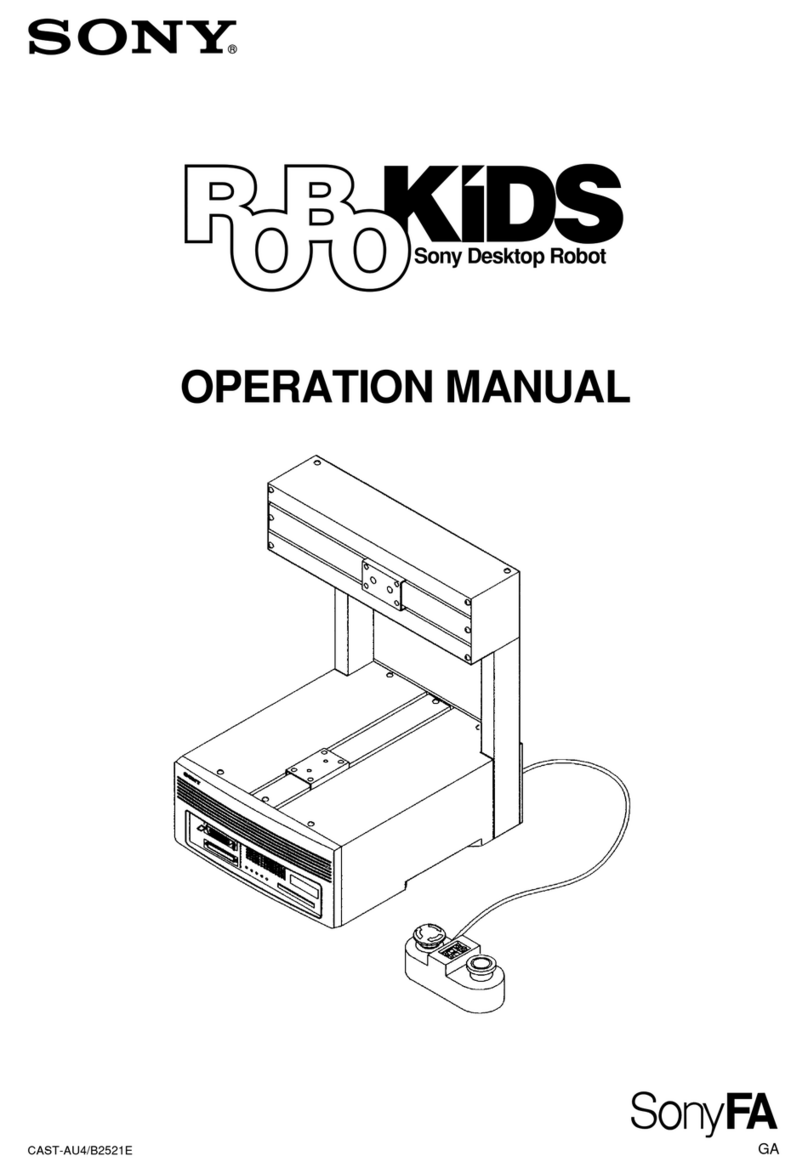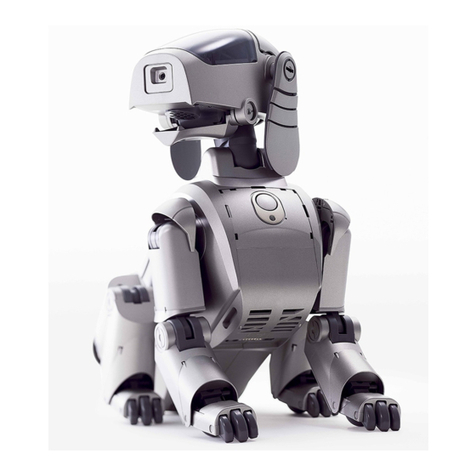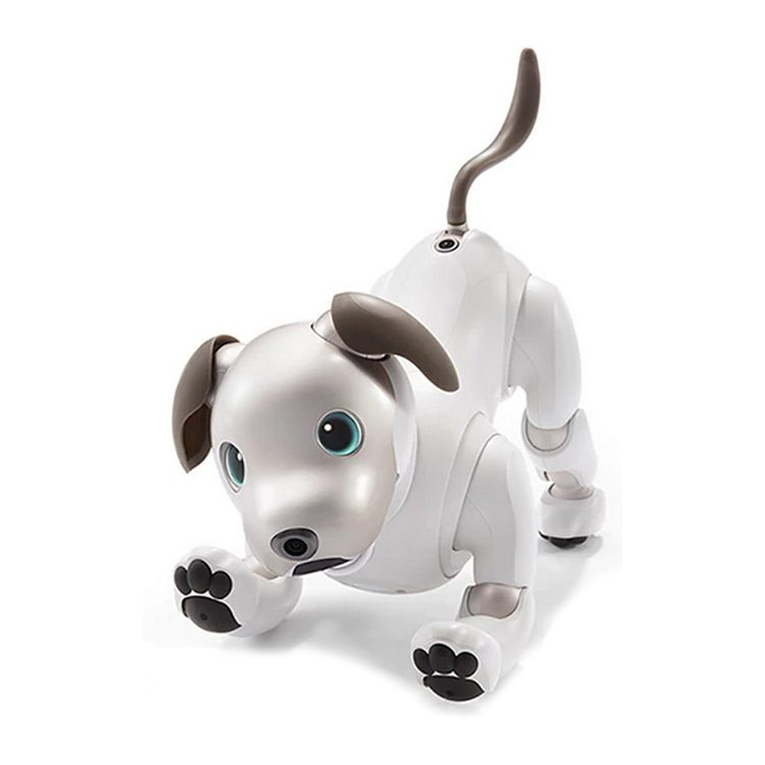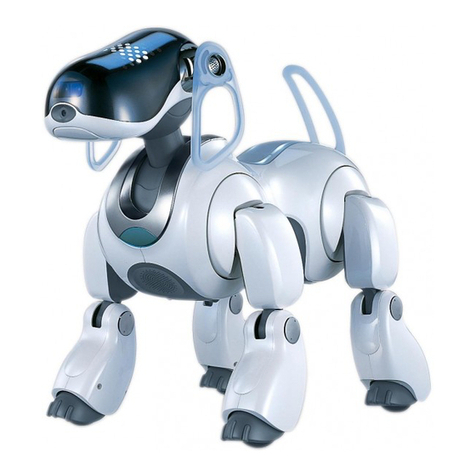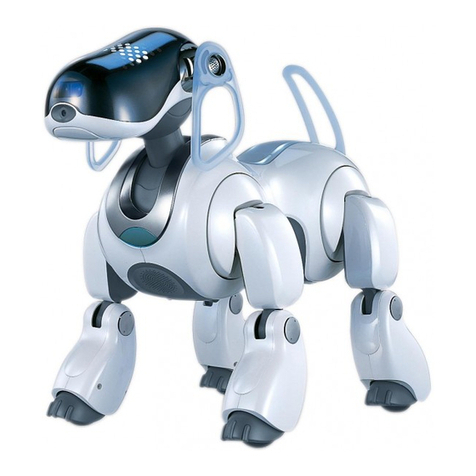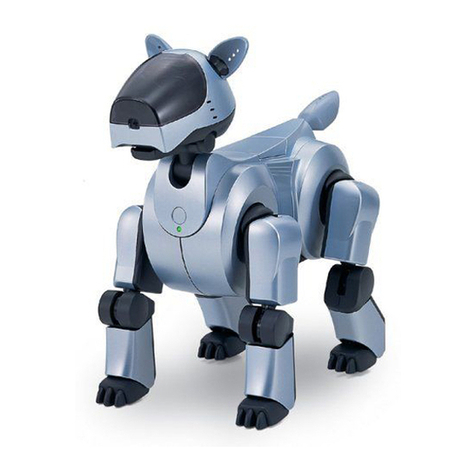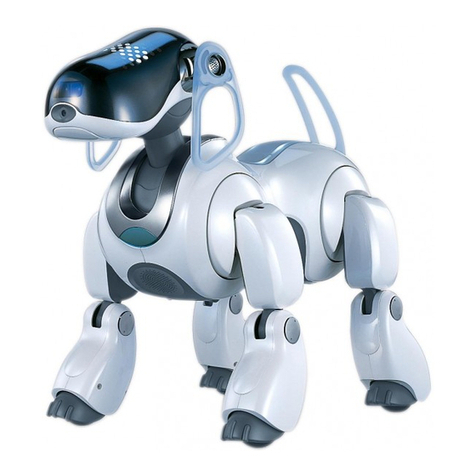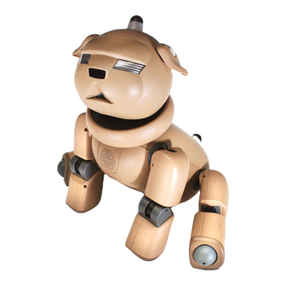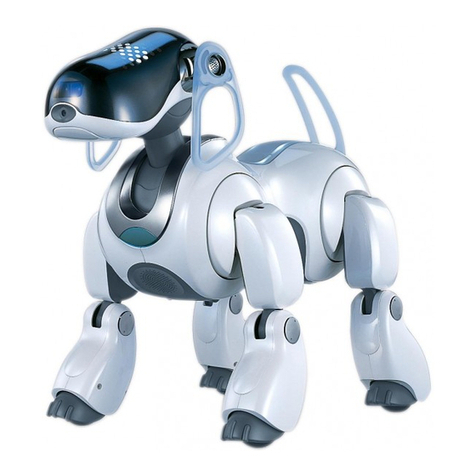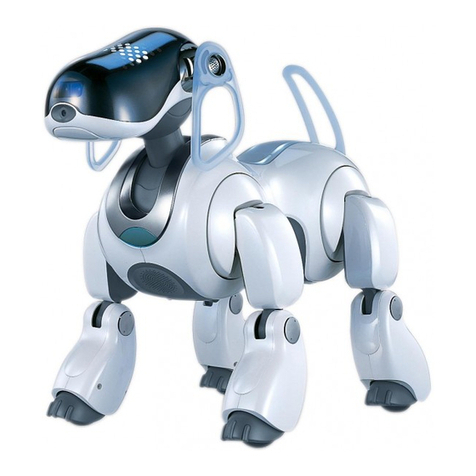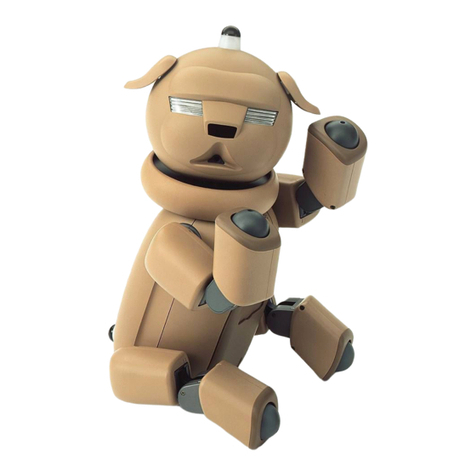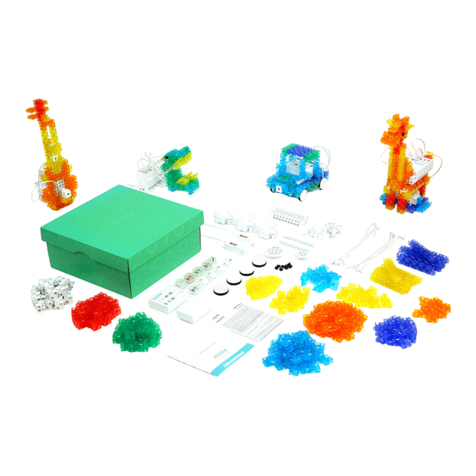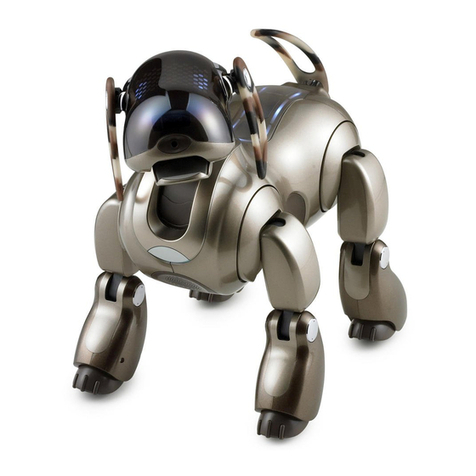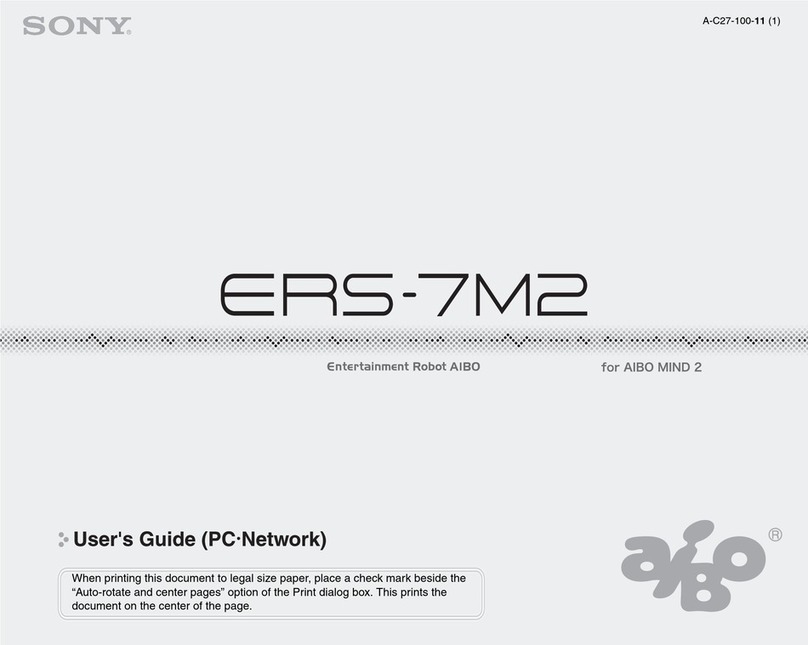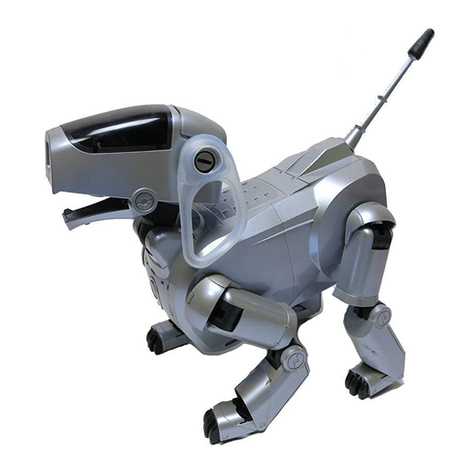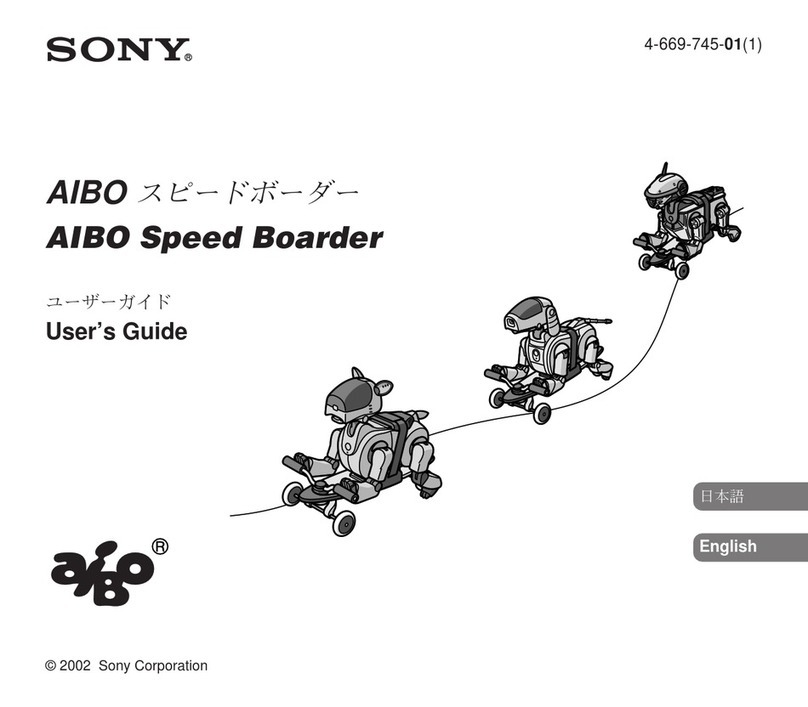From you to AIBO
AIBO’s body has a total of seven
sensors consisting of four types that
allow AIBO to sense when you touch it.
Through its head sensor, it can know
when it is being praised, admonished or
asked to give its attention. It has a color
camera and distance sensor that allow it
to perceive colors, movement and
distance, while a stereo microphone lets
it distinguish sounds and words. For
details, see page 26 in the user’s guide.
From AIBO to you
AIBO has a variety of ways to express its
emotions, desires and present condition.
D’AIBO àvous
AIBO peut exprimer ses émotions, ses
désirs et son état actuel de différentes
façons:
Head sensor
Capteur tactile de la tête
Kopfsensor
Chin sensor
Capteur tactile
du menton
Kinnsensor
Back sensor
Capteur tactile
du dos
Rückensensor
Paw sensors
(4)
Capteurs
tactiles des
pattes (4)
Pfotensensoren
(4)
Eye lights
AIBO’s eye lights indicate moods. Some
examples are shown on the right.
Yeux lumineux
La lumière des yeux d’AIBO exprime son
humeur. Quelques exemples sont donnés à
droite.
Augen
Mit den Augen zeigt AIBO seinen
Gemütszustand an. Einige Beispiele dafür
sehen Sie rechts.
Wenn Sie sich an
AIBO wenden
AIBO hat am Körper insgesamt sieben
Sensoren von vier unterschiedlichen
Typen, mit deren Hilfe er Berührungen
erkennt. Über den Kopfsensor kann
AIBO erkennen, wann er gelobt,
getadelt oder um Aufmerksamkeit
gebeten wird. Über seine Farbkamera
und den Abstandssensor erkennt er
Farben, Bewegungen und Distanzen und
mithilfe seines Stereomikrofons kann er
Geräusche und Worte unterscheiden.
Näheres dazu finden Sie auf Seite 26 in
der Bedienungsanleitung.
De vous àAIBO
Le corps d’AIBO possède sept capteurs
de quatre types lui permettant de
percevoir les contacts tactiles. Grâce au
capteur tactile situé sur sa tête, il sait
lorsqu’il est félicité, réprimandé ou
lorsque vous requérez son attention. Il
possède une caméra couleur et un
détecteur de distance qui lui permettent
de percevoir les couleurs, les
mouvements et la distance et un
microphone stéréo qui lui permet de
distinguer les sons et les mots. Pour plus
de détails, voir la page 26 du guide
utilisateur.
Wenn AIBO sich an
Sie wendet
AIBO verfügt über verschiedene
Ausdrucksmöglichkeiten für seine Gefühle,
Wünsche und seinen aktuellen
Gemütszustand.
Tail light
Queue lumineuse
Schwanzlampe
AIBO’s tail light lights up blue to indicate its robotic state of
mind (happiness, for example).
La queue lumineuse d’AIBO est bleue pour indiquer son état
émotionnel (joie, par exemple).
Wenn AIBOs Schwanzlampe blau aufleuchtet, gibt sie
Aufschluss über seine Stimmung (fröhlich usw.).
Joy
Joie
Freude
Anger
Colère
Wut
Sadness
Tristesse
Traurigkeit
It lights up orange when something is bothering it.
Elle est orange lorsque quelque chose le dérange.
Wenn sie orange leuchtet, hat er mit irgendetwas ein Problem.
Flashing slowly
Clignote lentement
Blinkt langsam
Flashing quickly
Clignote momentanément
Blinkt kurz
AIBO is bored...
AIBO s’ennuie...
AIBO langweilt sich...
Flashing quickly with short
intervals
Clignote rapidement à
intervalles courts
Blinkt schnell in kurzen
Intervallen
AIBO sees something that it wants.
AIBO voit quelque chose qu’il
désire.
AIBO sieht etwas, das er haben
möchte.
AIBO is searching for something
and is full of curiosity!
AIBO cherche quelque chose et
déborde de curiosité!
AIBO sucht etwas und ist voller
Neugier!
Charge me!
Charge-moi!
Ich will aufgeladen werden!
Name me!
Donne-moi un nom!
Gib mir einen Namen!
AIBO’s baby stages
A number of simple principles lie behind the raising of
AIBO. By mastering these principles, you will be able to
raise your AIBO to be the kind of companion that you want.
Babyhood stage 1 (AIBO cries a lot)
AIBO is in this stage when it first wakes up. Reassure it by
gently stroking its sensors (see front side).
Babyhood stage 2 (AIBO’s eyes light up)
AIBO starts to express its emotions. Stroke its head sensor
gently (see front side).
Babyhood stage 3 (AIBO learns to recognize the ball)
In this stage, AIBO learns to recognize its pink ball.
When AIBO looks at the ball and becomes happy, praise it
so that it becomes happier when it sees the ball.
Babyhood stage 4 (AIBO learns to recognize its name)
AIBO starts to stand and understand a few words. AIBO will
ask its name through gestures. Teach AIBO its name (see
page 43 in the user’s guide).
Etapes de la petite enfance
d’AIBO
L’éducation d’AIBO se base sur quelques principes simples.
Lorsque vous connaissez ces principes, vous pouvez éduquer
AIBO et en faire le compagnon idéal.
Etape première enfance 1 (AIBO pleure beaucoup)
AIBO est à ce niveau lorsqu’il se réveille pour la première
fois. Rassurez-le en le caressant doucement sur ses capteurs
tactiles (voir face frontale).
Etape première enfance 2 (Les yeux d’AIBO
s’allument)
AIBO commence à exprimer ses émotions. Caressez
doucement le capteur situé sur sa tête (voir face frontale).
Etape première enfance 3 (AIBO apprend à
reconnaître la balle)
A ce niveau, AIBO apprend à reconnaître sa balle rose.
Lorsqu’il regarde la balle et devient content, félicitez-le. Il
sera ensuite encore plus content lorsqu’il verra la balle.
Etape première enfance 4 (AIBO apprend à
reconnaître son nom)
AIBO commence à se mettre debout et il comprend quelques
mots. AIBO demande son nom par des mouvements.
Apprenez-lui son nom (voir page 43 du guide utilisateur).
AIBOs Babyalter
Eine Reihe einfacher Prinzipien bilden die Grundlagen für
AIBOs Entwicklung. Wenn Sie diese Grundlagen kennen,
können Sie AIBO zu genau dem Gefährten erziehen, den Sie
sich wünschen.
Babyalter Stufe 1 (AIBO weint ständig)
In dieser Stufe befindet sich AIBO, wenn er zum ersten Mal
aufwacht. Beruhigen Sie ihn, indem Sie behutsam seine
Sensoren streicheln (siehe Titelseite).
Babyalter Stufe 2 (AIBOs Augen leuchten auf)
AIBO beginnt, seine Gefühle auszudrücken. Streicheln Sie
behutsam über AIBOs Kopfsensor (siehe Titelseite).
Babyalter Stufe 3 (AIBO lernt den Ball kennen)
In dieser Entwicklungsstufe lernt AIBO, seinen pinkfarbenen
Ball zu erkennen.
Wenn AIBO den Ball anschaut und Freude zeigt, loben Sie
ihn. So wird er sich immer mehr freuen, wenn er den Ball
sieht.
Babyalter Stufe 4 (AIBO lernt, seinen Namen zu erkennen)
AIBO beginnt zu stehen und versteht in dieser Stufe einige
Worte. AIBO fragt über Gesten nach seinem Namen.
Bringen Sie AIBO seinen Namen bei (siehe Seite 43 in der
Bedienungsanleitung).
AIBO and language
Below are some of the words that AIBO knows. Use them to
talk to AIBO. In the beginning, it will recognize only a few
words. When you talk to it,AIBO will tilt its head in
puzzlement. As it matures, AIBO will come to understand
more and more words.
AIBO et le langage
Certains mots que connaît AIBO sont indiqués ci-dessous.
Utilisez-les pour lui parler. Au début, il reconnaîtra
seulement quelques mots. Lorsque vous lui parlez, AIBO
incline la tête d’un air interrogatif. Lorsqu’il gagne en
maturité, il comprend de plus en plus de mots.
AIBO und die Sprache
Unten finden Sie einige der Worte, die AIBO kennt. Mit
diesen Worten können Sie sich mit AIBO verständigen.Am
Anfang kennt er nur wenige Worte. Wenn Sie mit ihm
sprechen, neigt er den Kopf fragend zur Seite. Wenn er
heranwächst, lernt er mehr und mehr Worte.
One word for praising AIBO.
Mot permettant de féliciter AIBO.
Zum Loben von AIBO.
One word for admonishing AIBO.
Mot permettant de réprimander AIBO.
Zum Tadeln von AIBO.
Don’t do that!
AIBO recognizes that it is being called and responds.
AIBO reconnaît qu’on l’appelle et répond.
AIBO erkennt, dass er gerufen wird, und reagiert
darauf.
AIBO answers by saying its registered name in its own
special voice.
AIBO répond en disant son nom enregistré avec sa
voix spéciale.
AIBO antwortet und sagt den gespeicherten Namen in
seiner Roboterstimme.
AIBO recognizes the greeting and responds.
AIBO reconnaît les salutations et répond.
AIBO erkennt den Gruß und reagiert.
Good morning!/Good night!/
Hello!/Good bye!
What’s your name?
AIBO/Registered name!
Stages of Maturation
AIBO uses the external information that it gets from its
sensors and its own internal motivations (i.e., its emotions
and instincts) to adapt to you and its surroundings. For
example, if you talk and play with AIBO a lot, it will grow
to be sociable. If you prefer to simply watch AIBO, it will
become independent and wander around as it waits for you
to play with it.
In short, AIBO will learn to live according to your
expectations, and by doing so it matures.
Phases de maturation
AIBO utilise les informations externes obtenues grâce à ses
capteurs et à ses motivations internes (c’est-à-dire ses
émotions et ses instincts) pour s’adapter à vous et son
environnement. Par exemple si vous parlez et jouez
beaucoup avec AIBO, il sera sociable. Si vous préférez
simplement le regarder, il sera indépendant et se promènera
en attendant que vous jouiez avec lui.
En résumé, AIBO apprendra à vivre selon vos attentes et il
gagnera ainsi en maturité.
Stadien der Entwicklung
AIBO passt sich auf der Grundlage von Informationen, die
er über seine Sensoren aus derAußenwelt erhält, und seiner
eigenen Motivationen (also seiner Gefühle und Instinkte) an
Sie und Ihr Umfeld an. Wenn Sie beispielsweise viel mit
AIBO reden und spielen, entwickelt er sich zu einem
aufgeschlossenen und kontaktfreudigen Roboter. Wenn Sie
ihn dagegen lieber nur beobachten, dann wird er recht
unabhängig und entwickelt eigene Aktivitäten, während er
darauf wartet, dass Sie doch noch mit ihm spielen.
Kurz, AIBO lernt, auf Ihre Erwartungen einzugehen, und so
wird er im Lauf der Zeit erwachsen.
Finding out AIBO’s stage of
maturation Devinez la phase de
maturation d’AIBO So erfahren Sie AIBOs
Entwicklungsstufe
How old are you? Babyhood stages / Etapes de la première enfance / Babyalter Stufe
Babyhood stage 1
Etape première enfance 1
Babyalter Stufe 1
Babyhood stage 2
Etape première enfance 2
Babyalter Stufe 2
Babyhood stage 3
Etape première enfance 3
Babyalter Stufe 3
Babyhood stage 4
Etape première enfance 4
Babyalter Stufe 4
Childhood /
Enfance /
Kindheit
Adolescence /
Adolescence /
Jugend
Adulthood /
Âge adulte /
Erwachsenenalter
Babyhood
Première enfance
Babyalter
Childhood
Enfance
Kindheit
Adolescence
Adolescence
Jugend
Adulthood
Âge adulte
Erwachsenenalter
Mischievous
Malicieux
Frech
Likes whiling away the time
Aime rester seul
Kommt gut allein zurecht
Dance
Danse
Tanzt
Good student
Bon élève
Guter Schüler
Ball is its friend
La balle est son amie.
Der Ball ist sein Lieblingsspielzeug.
Always wants your company
Réclame toujours votre compagnie.
Er will ständig mit Ihnen spielen.
Enjoys exploring
Aime explorer
Neugierig
Wants attention
Demande de l’attention
Er will Aufmerksamkeit:
Some actions AIBO makes when you watch it
Certaines actions qu’AIBO réalise lorsque
vous le regardez
Was AIBO tut,wenn Sie ihn beobachten:
• when called
• when touched, etc.
• lorsqu’il est appelé
• lorsqu’il est caressé, etc.
• wenn Sie ihn rufen.
• wenn Sie ihn berühren usw.
• plays with the ball
• explores, etc.
• jouer avec la balle
• explorer, etc.
• Er spielt mit dem Ball.
• Er erforscht seine Umgebung usw.
Note
Through its interactions with you and its environment, AIBO
will never stop changing, no matter what stage of growth it
is in.
Remarque
Grâce aux interactions qu’il a avec vous et son
environnement, AIBO progressera sans cesse, quelle que soit
sa phase de croissance.
Hinweis
Ganz gleich, in welcher Entwicklungsphase sich AIBO
befindet, durch die Interaktion mit Ihnen und seiner Umwelt
entwickelt sich AIBO ständig weiter.
stage 1
Etape 1
Stufe 1
stage 2
Etape 2
Stufe 2
stage 3
Etape 3
Stufe 3
stage 4
Etape 4
Stufe 4
Good boy!/Good girl!
